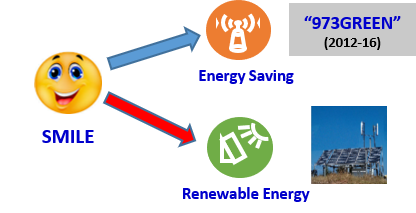Green
As traffic demands further grow, the increase of the energy consumption in wireless networks has become a key concern in 5G era. A fundamental question then arises: can we send more information bits with less energy (SMILE)? Of course, the answer is yes. One approach is to make the service provisioning more adaptive to the traffic dynamics, i.e. to save energy. Another approach is to exploit renewable energy by energy harvesting technologies. As the harvested energy is highly unstable, it has to be managed in order not to cause much performance degradation when the harvested energy is not enough, whereas not to waste the harvested energy too much when it is more than enough. For this purpose, the energy management in wireless networks needs to be jointly optimized with the availability of the energy, the battery state, as well as the content and the distribution (both temporal and spatial) of the traffic demands.The research topics includes:
- Cloud-based and Software-defined Hyper-Cellular Networks
- Wait-and-See: Optimal Sleeping Policy for Servers with Bursty Traffic
- Beam-Based Solutions for Cost-Efficient Massive MIMO Systems
SMART
Wireless networks of the future will be featured by heterogeneity of spectrum usage regimes, of resource ownership models, of radio access technologies, and of the locus of processing. Such a diversity brings increased complexity in allocating and managing those network resources such that the networks themselves have to be much smarter than before. Machine learning (ML) techniques can come to the rescue, taming the complexity. A fundamental question then arises: how to make the decision-making process robust and also in a timely manner? In this regard, the network intelligence should be generated locally (at the fog/edges or even embedded in the terminals) and then spread out to the whole network. Computing jobs should be optimally distributed over the network. It should also be combined with the control/data-decoupled hyper-cellular architecture and intent-based networking schemes.The research topics includes:
- Exploiting Moving Intelligence: Task Offloading in Vehicular Networks
- Learning-based Channel State Information Inference
AUTONOMOUS
With the help of AI, the decision-making in future wireless networks should exhibit intellective awareness beyond primitive actions, interpret and translate high-level (possibly vague) instructions into concrete actions, employ a variety of representation and reasoning mechanisms, learn from their own experiences and those of other entities, and ultimately self-configure, organize, optimize and protect themselves. Such an autonomous infrastructure necessitate a paradigm shift of the network control mechanism from centralized to distributed manner based on semantic, probabilistic and commonsense reasoning. As a result, how to guarantee the latency, reliability, and regularity of the status updating information is crucial. In this regard, a new performance metric called “age of information” has been introduced, which is basically the time elapsed since the generation of the last update (TESLU).The research topics includes:
- Timely Status Update in Massive IoT: Regular Delivery and AoI Optimization



